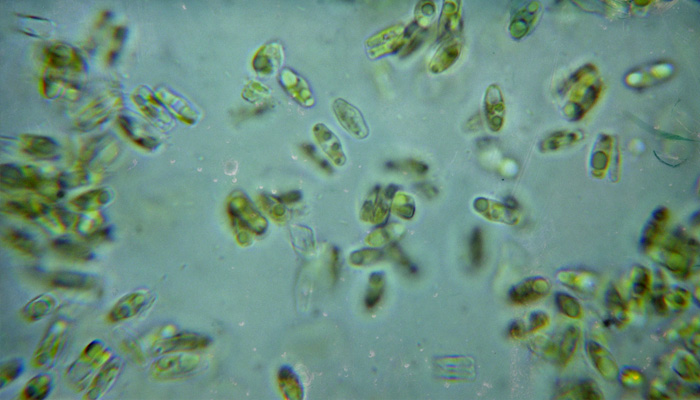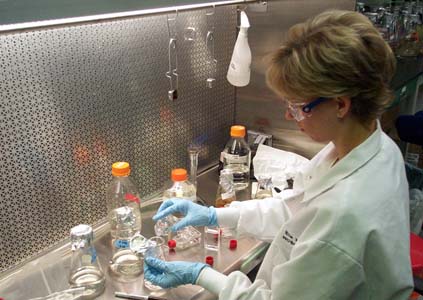
Algal Culture and Microbiology Laboratory
Algal cultures
The CAAE supports research on freshwater, estuarine and marine harmful algae. Species from harmful algal blooms are isolated and cultured in the algal culture laboratory. The CAAE presently maintains 80 algal species in culture, including 200 strains of various heterotrophic dinoflagellates as well as phototrophs and mixotrophs. The taxa include:
- Estuaries: heterotrophic dinoflagellates (Pfiesteria spp., cryptoperidiniopsoids, others), raphidophytes (Heterosigma akashiwo, Chattonella subsalsa)
- Estuaries and marine coasts: mixotrophic dinoflagellates (Karenia brevis, Karlodinium veneficum, Alexandrium monilatum, Alexandrium tamarense)
- Freshwaters and estuaries: mixotrophic and phototrophic cryptophytes, chlorophytes, diatoms, haptophytes (e.g. Pavlova sp., Prymnesium parvum)
- Freshwater cyanobacteria (Anabaena spp., Anabaenopsis spp., Cylindrospermopsis spp., Lyngbya spp., Microcystis spp., Raphidiopsis sp.)
Phytoplankton community assessment
The CAAE will provide phycological services to students and research programs upon request.
Phytoplankton Community Assessment Services include phytoplankton assemblage identification, enumeration and biovolume analysis for freshwater, estuarine and marine systems.
The Utermöhl and Palmer-Maloney methods are used for estimating algal numbers. Qualitative algal identification or quantitative analysis can be performed.
Please contact the algal lab manager for project specific pricing.
Past Projects include:
- US EPA 2012 National Lake Assessment
- City of Raleigh, Falls Lake (2004 – present)
- City of High Point, High Point City Lake, Oak Hollow Lake (2002 – present)
- NC DHHS – Cyanobacteria and cyanotoxins in North Carolina Surface Waters (2002 – 2007)
- Neuse River Estuary Monitoring and Research Program (1993 – present)
Bacterial cultures
 Additionally, the laboratory became state-certified in 2010 in the detection of pathogenic bacteria, which can be used as indicators to assess the microbiological quality of water. The CAAE maintains cultures of Enterococcus faecium and Escherichia coli to satisfy requirements for the testing of enteroccci and fecal coliform.
Additionally, the laboratory became state-certified in 2010 in the detection of pathogenic bacteria, which can be used as indicators to assess the microbiological quality of water. The CAAE maintains cultures of Enterococcus faecium and Escherichia coli to satisfy requirements for the testing of enteroccci and fecal coliform.
Culturing facilities include:
- NuAire (NU-201-630) laminar flow hood
- Percival E75L1 plant growth chamber (71.6 ft3)
- Caron 6030 environmental chamber (30 ft3)
- IDEXX Quanti-Tray Sealer Model 2X
- Spectroline Model CM-10 Fluorescence Analysis Cabinet
- Primus sterilizer
- Two walk-in cold rooms
- -80°C freezer (media, toxin sample storage)
- incubators and waterbaths
